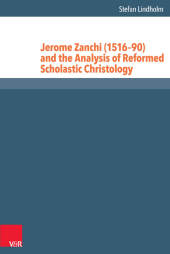 Neuerscheinungen 2016Stand: 2020-02-01 |
Schnellsuche
ISBN/Stichwort/Autor
|
Herderstra▀e 10
10625 Berlin
Tel.: 030 315 714 16
Fax 030 315 714 14
info@buchspektrum.de |

Stefan Lindholm
Jerome Zanchi (1516-90) and the Analysis of Reformed Scholastic Christology
Dissertationsschrift
2016. 200 S. 232 mm
Verlag/Jahr: VANDENHOECK & RUPRECHT 2016
ISBN: 3-525-55104-5 (3525551045)
Neue ISBN: 978-3-525-55104-2 (9783525551042)
Preis und Lieferzeit: Bitte klicken
The Christology of a leading 16th century reformed scholastic theologian
This is a study in the Christology of Jerome Zanchi (1516-90), a leading 16th century reformed scholastic theologian. The study as a whole is bound together by doctrinal topics, themes and trajectories important to the 16th century Christological debates as well as by philosophical issues and arguments.In the first chapter, Stefan Lindholm situates Zanchi in the contemporary research into reformed scholasticism. Lindholm gives an account of what he calls ┤analytic Christology┤ and why it is relevant to the present study. In the second chapter, he contextualizes Zanchi┤s Christology, historically and theologically. He discusses the sources and context of Zanchi┤s Christology and characterize it as catholic, scholastic and reformed.In the second part, on the hypostatic union, Lindholm evaluates Zanchi┤s view of the virgin birth - The process of hominization - in the third chapter. In the fourth chapter, he analyses Zanchi┤s uses of the part-whole and soul-body similes for the hypostatic union. What emerges is a rather ambiguous view of the hypostatic union. At the end of this chapter, Lindholm offers further correctives to Zanchi┤s assumed metaphysical framework in order to better accommodate the sort of claims Zanchi wants to make about the hypostatic union.The central theme in the debate between the Lutherans and the reformed theologians, the communication of properties, is treated in the third part. Chapter five deals with Zanchi┤s controversy with Martin Chemnitz┤ notion of the majestic genus (genus maiestaticum). In the sixth chapter Lindholm discusses the most heated issue in the debate about the communication of properties: ubiquity. He shows that Zanchi tends to argue against a sort of generalized version of ubiquity but it is not clear that Chemnitz actually ascribed to that position which weakens the force of Zanchi┤s arguments. Finally, Lindholm looks at two scholastic arguments found in Chemnitz for multi-location and reconstruct a possible Zanchian response to them.In a postscript, Lindholm suggests some trajectories for future research.
Lindholm, Stefan
Dr. phil. Stefan Lindholm is an ordinand in the Lutheran Church in Sweden, editor for Theofilos at NLA University College, Norway, and has lectured at Link÷ping University and Johannelund Theological Seminary, Sweden.


